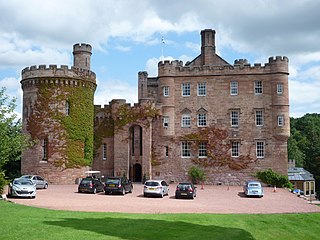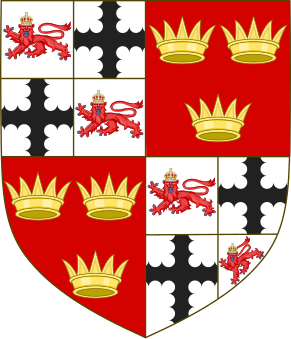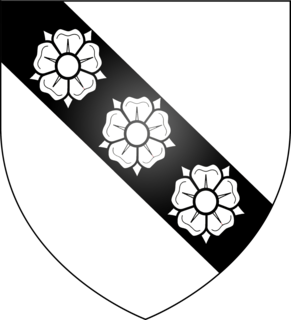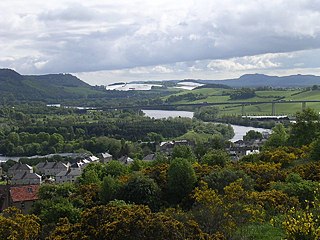Related Research Articles

Baron is a rank of nobility or title of honour, often hereditary, in various European countries, either current or historical. The female equivalent is baroness.
The Peerage of Ireland consists of those titles of nobility created by the English monarchs in their capacity as Lord or King of Ireland, or later by monarchs of the United Kingdom of Great Britain and Ireland. The creation of such titles came to an end in the 19th century. The ranks of the Irish peerage are Duke, Marquess, Earl, Viscount and Baron. As of 2016, there were 135 titles in the Peerage of Ireland extant: two dukedoms, ten marquessates, 43 earldoms, 28 viscountcies, and 52 baronies. The Crown of the United Kingdom of Great Britain and Northern Ireland continues to exercise jurisdiction over the Peerage of Ireland, including those peers whose titles derive from places located in what is now the Republic of Ireland. Article 40.2 of the Constitution of Ireland forbids the state conferring titles of nobility and a citizen may not accept titles of nobility or honour except with the prior approval of the Government. This issue has not arisen in respect of the Peerage of Ireland because, as observed above, no creation of titles in it has been made since the Constitution came into force.
The Peerage of the United Kingdom comprises most peerages created in the United Kingdom of Great Britain and Ireland after the Acts of Union in 1801, when it replaced the Peerage of Great Britain. New peers continued to be created in the Peerage of Ireland until 1898.
In early medieval Scotland, a mormaer was the Gaelic name for a regional or provincial ruler, theoretically second only to the King of Scots, and the senior of a Taoiseach (chieftain). Mormaers were equivalent to English earls or Continental counts, and the term is often translated into English as 'earl'.

Earl of Dalhousie, in the County of Midlothian, is a title in the Peerage of Scotland, held by the Chief of Clan Ramsay.

Earl of Strathmore and Kinghorne is a title in the Peerage of Scotland and the Peerage of the United Kingdom. It was first created as Earl of Kinghorne in Peerage of Scotland in 1606 for Patrick Lyon. In 1677, the designation of the earldom changed to "Strathmore and Kinghorne". A second earldom was bestowed on the 14th Earl in the Peerage of the United Kingdom in 1937, leading to him being titled as the 14th and 1st Earl of Strathmore and Kinghorne.

Earl of Seafield is a title in the Peerage of Scotland. It was created in 1701 for James Ogilvy, who in 1711 succeeded his father as 4th Earl of Findlater. The earldoms of Findlater and Seafield continued to be united until 1811, when the earldom of Findlater became dormant, while the earldom of Seafield remains extant.

Baron Hunsdon is a title that has been created three times.

Clan Lyon is a Scottish clan.

Gight is the name of an estate in the parish of Fyvie in the Formartine area of Aberdeenshire, Scotland, United Kingdom. It is best known as the location of the 16th-century Gight Castle, ancestral home of Lord Byron.
A barony is an administrative division of a county in Scotland, Ireland and outlying parts of England. It has a lower rank and importance than a county.
Alexander Leslie, Earl of Ross was a Scottish nobleman. Born between 1367 and 1382, he was the son of Walter Leslie, Lord of Ross and Euphemia I, Countess of Ross. In around 1394 he became Earl of Ross and sometime before 1398 he married Isabel Stewart, daughter of Robert Stewart, Duke of Albany. They had one child, Euphemia. He died at Dingwall, Scotland on 8 May 1402.
Clan Strachan is a Scottish clan originating from the barony of Strachan, in Aberdeenshire. The clan does not have a chief, therefore it is considered by Court of the Lord Lyon and the Stand Council of Scottish Chiefs as an Armigerous clan.

Clan Rattray is a Highland Scottish clan.

Gowrie is a region and ancient province of Scotland, covering the eastern sliver of what became Perthshire. It was located to the immediate east of Atholl, and originally included the area around Perth, though that was later detached as Perthia.

William de Moravia was the 5th Earl of Sutherland and chief of the Clan Sutherland, a Scottish clan of the Scottish Highlands. William, 5th Earl of Sutherland was a loyal supporter of David II of Scotland in the wars against England.
The Lordship and Barony of Hailes is a Scottish feudal lordship.

Clan Bissett is a Scottish clan. The clan is recognised by the Lord Lyon King of Arms but does not have a clan chief recognised by the Lord Lyon King of Arms, therefore the clan has no standing under Scots Law. Clan Bissett is considered an armigerous clan, meaning that it is considered to have had at one time a chief who possessed the chiefly arms; however, no one at present is in possession of such arms. The surname Bissett is also considered a sept of the Clan Fraser of Lovat.
Thane was the title given to a local royal official in medieval eastern Scotland, equivalent in rank to the son of an earl, who was at the head of an administrative and socio-economic unit known as a thanedom.

Stobo is a title in the Baronage of Scotland which takes its name from Stobo in the Scottish Borders.
References
- Groome, Francis H. Ordnance Gazetteer of Scotland (1882-4).